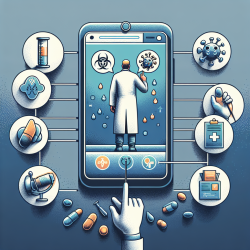Tele-Harm Reduction: A Game-Changer for Practitioners
As a practitioner in the field of special education and therapy services, it's crucial to stay updated with innovative interventions that can significantly impact the communities we serve. One such groundbreaking intervention is the Tele-Harm Reduction (THR) model, as detailed in the research article titled "Project T-SHARP: study protocol for a multi-site randomized controlled trial of tele-harm reduction for people with HIV who inject drugs."
Understanding Tele-Harm Reduction
The resurgence of HIV outbreaks, especially among people who inject drugs (PWID), presents a significant challenge. Traditional healthcare models often fail to meet the needs of this community due to various barriers, including stigma and accessibility issues. Tele-Harm Reduction is an innovative telehealth-enhanced intervention designed to overcome these challenges by leveraging syringe services programs (SSPs).
Key Components of Tele-Harm Reduction
- Telehealth Technology: Utilizes secure, HIPAA-compliant videoconferencing to connect participants with healthcare providers, ensuring privacy and confidentiality.
- Peer Support: Engages peers with lived experience to facilitate adherence and bridge the digital divide, making healthcare more accessible and relatable.
- Onsite Services: Provides on-site phlebotomy and medication management, including storage in pill lockers and flexible delivery options.
Impact on Practitioners
For practitioners, the THR model offers a novel approach to delivering care that is both effective and compassionate. By integrating telehealth with harm reduction strategies, practitioners can:
- Enhance Accessibility: Reach clients who face barriers to traditional healthcare settings, such as transportation or stigma.
- Improve Adherence: Utilize peer support to encourage medication adherence and engagement in care.
- Foster Innovation: Incorporate cutting-edge telehealth solutions into practice, staying ahead in the field.
Encouraging Further Research
The T-SHARP trial is a call to action for practitioners to delve deeper into telehealth interventions and harm reduction strategies. By participating in or conducting further research, practitioners can contribute to refining these models, ensuring they are tailored to the unique needs of diverse populations.
For those interested in exploring the detailed outcomes and methodologies of the T-SHARP trial, the original research paper offers a comprehensive insight. Project T-SHARP: study protocol for a multi-site randomized controlled trial of tele-harm reduction for people with HIV who inject drugs
Conclusion
Tele-Harm Reduction represents a paradigm shift in how we approach healthcare for marginalized communities. As practitioners, embracing such innovations not only enhances our practice but also significantly impacts the lives of those we serve. Let’s continue to explore, research, and implement these transformative strategies.










